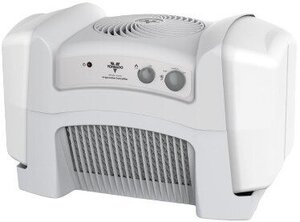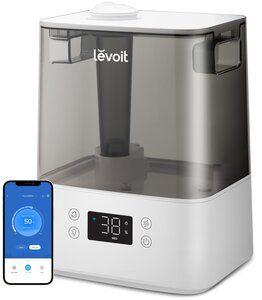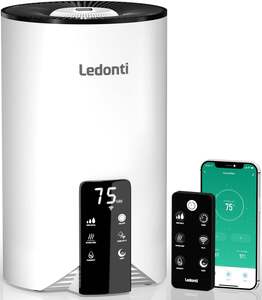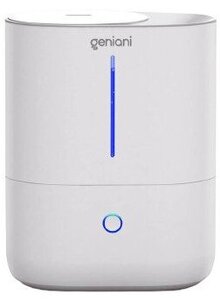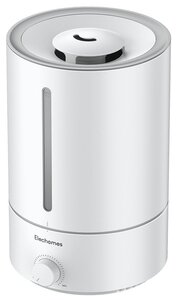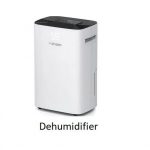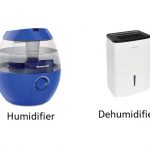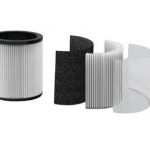5 Best Humidifiers For Greenhouse
When engaging in greenhouse farming, humidifiers can be significantly useful to you. This is because most plants in greenhouses require constant humidity levels. If the humidity is unbalanced, plants tend to get affected.
Low humidity usually causes stunted growth and slowed photosynthesis. Similarly, excessive humidity can also affect plants in greenhouses. It brings about mineral deficiencies, edge burn, and oedama in some plants, especially those plants that thrive under low humidity. In this regard, you need to control the humidity in your greenhouse according to the type of plants you have.
There are many ways to increase humidity in your greenhouse. However, we find a humidifier the best solution. Most humidifiers come with humidity sensors. These help the humidifier to detect the current humidity levels and automatically adjust the mist output accordingly.
If you are wondering how you can get a good humidifier for your greenhouse, we can help you out. In this article, we have selected some of the best humidifiers for a greenhouse. You can check them out and identify which can be of great help to you.
Summary Of Our Selected Humidifiers For Greenhouse
| Humidifier | Vornado Evap40 4-Gallon Evaporative Humidifier | Levoit Classic 300S | Ledonti HLD-421Humidifier | Geniani Huron Top Fill Humidifier | Elechomes 5L US5001 Humidifier |
| Humidistat | ✓ | ✓ | ✓ | ✓ | ☓ |
| Area Coverage | 1000 ft2 | 505 ft2 | 300 ft2 | 220 ft2 | 322 ft2 |
| Max. Run Time | 24H | 60H | 20H | 18H | 60H |
| Tank Capacity | 3.8L | 6L | 4L | 4L | 5L |
| Easy to clean | Yes | Yes | Yes | Yes | Yes |
Before we discuss the details of these humidifiers, let’s first answer some of these frequently asked questions.
How To Add Humidity To A Greenhouse
Adding humidity to the greenhouse can be done in various ways. Some of these include;
- Watering
Watering does not only help prevent the plant from drying out but also increases humidity. When you detect low humidity in a greenhouse you can spray water on your plants and on the floor. This sprayed water will later evaporate and increase the humidity level within the greenhouse.
- Place Bowls Of Water In The Greenhouse
If you do not want to wet your greenhouse floor, you can use bowls. The water in the bowl gradually evaporates, which increases humidity. To be on the safe side, it is important you place bowls in different areas of the greenhouse. This will help increase humidity swiftly throughout the greenhouse.
- Place Pebble Trays Next to a Plant
Fill the pebble trays with water and place them next to plants that need high humidity. The logic behind placing the trays next to the plant is that when evaporation takes place, moisture moves directly to the plant.
- Improve Ventilation System
A good ventilation system can help you regulate your greenhouse humidity. When the humidity becomes high, ventilation can reduce it. Ventilation allows indoor and outdoor air exchange. The ventilation system can help bring in humid air from outside and force out the dry air.
- Use a Humidifier
This is the most reliable way to add favorable humidity levels in a greenhouse. Humidifiers work by generating moisture to increase humidity. Some of them can run automatically, which helps maintain a particular range of humidity. With such humidifiers, you minimize the risk of generating less or excessive humidity both of which affect plants. In case you wondering how you can get a good humidifier for a greenhouse, scroll down and see those that can be good for you.
How To Ventilate A Greenhouse In Winter
Greenhouse ventilation is all about removing the inside stale air and replacing it with a fresh one from the outside. Good ventilation can help you maintain good levels of humidity in a greenhouse. In winter, greenhouses can be ventilated both naturally and mechanically as discussed below.
Natural Ventilation
Natural ventilation uses roof and sidewall vents. These two work together to ensure there is air exchange in the greenhouse. Usually, the sidewall vents are put closer to the ground. When the temperature in the greenhouse increases, the air also becomes hot. As the laws of physics dictate, the hot air will always rise up. So, when it rises, it is forced out through the vents at the roof of the greenhouse.
As hot air moves out, it leaves a vacuum inside. This allows cool and fresh air to enter through the sidewall vents. Ultimately, this helps you add more humidity to your greenhouse.
However, since it is winter, the air entering is so cold. This cold air can significantly affect our plants in the greenhouse in many ways. These include wilting, blackening, and curling of leaves. To avoid this problem, you need to add heat to the greenhouse. You can use fan heaters or any other air heating system. Notably, you need to regulate the heat as it may affect the crops or reduce humidity.
Mechanical Ventilation
- Installation of Ventilation Pans
As discussed above, when ventilating a greenhouse, the heating system is very important. This helps warm up the cold air entering the greenhouse. This is why you need to install ventilation pans. They are usually constructed under the roof. These ensure the air coming into the greenhouse is warmed before reaching the plants.
For those who are reluctant to install ventilation pans, you can use fan heaters. They can also help warm the cold air coming into the greenhouse. You may be asking whether the electricity bills will not shoot up. Well, like any other product containing a heating element, the energy consumption rate is always expected to increase. But you can use temperature monitors such as a thermometer. This can help you heat the greenhouse only when it is necessary.
- Use Circulation Fan
Circulation fans help keep the air in motion. This works by preventing the warm air from moving up and the cold air from going closer to the ground. Certainly, this prevents air stagnation in an enclosed greenhouse. In this regard, humidity and temperature can remain balanced. The most important aspect about using circulation fans is that you can use them in all seasons.
Remember, you can expect a high energy consumption during the time you heat the air. But, you can minimize power consumption by using temperature and humidity monitoring devices.
Devices such as thermometers and hygrometers can help you regulate the use of heating systems. This is because you can always determine when to run the fan and when not to. Therefore, you can manage energy consumption and prevent the bills from skyrocketing.
How To Humidify Greenhouse Quickly
If you want to humidify a greenhouse quickly, you can use a humidifier. Humidifiers use a mechanical process that allows them to generate moisture quickly. When set to maximum humidification speed, most humidifiers can restore good levels of humidity in less than 30 minutes.
Should I Put A Humidifier In My Greenhouse
Yes, you can put a humidifier in your greenhouse. In case, the humidity levels in your greenhouse fluctuate or are completely low, you can use a humidifier. Humidifiers help maintain good levels of humidity by adding moisture. So, if you are sensing dry air in your greenhouse, it is advisable to use a humidifier.
When Should I Put A Humidifier In My Greenhouse
Putting a humidifier in your greenhouse can be based on the type of plants, their growth levels, and even temperature. Different types of plants at different growth stages require varying levels of humidity. Moreover, most seedlings require 95% humidity levels. But, as they grow, they become comfortable with a relative humidity of about 55 to 97% depending on the plant. This means when the humidity drops below these thresholds, you need to put a humidifier in your greenhouse.
However, before adding a humidifier, you need to determine the right humidity level for the plants in your greenhouse. This will help you not to generate too much or too little humidity for your plants.
Additionally, temperatures may determine whether you should add a humidifier or not. When temperatures are low, the air in the greenhouse loses humidity. This is because cold air loses more humidity than warm air. In this case, you can also put a humidifier in your greenhouse.
You may also want to know the time to use a humidifier in your greenhouse. Well, this may depend on the humidity levels in your greenhouse. But, it is better to use a humidifier from early morning till around midday. This gives time for the plants to absorb much humidity during this time compared to night time. Ultimately, this minimizes the risk of mold or fungus growth.
Nevertheless, if the humidity level in your greenhouse is always low, then you may need to run your humidifier for an extended time.
Best Humidifiers For Greenhouse
1. Vornado Evap40 4-Gallon Evaporative Humidifier
We have selected Vornado Evap40 as one of the best humidifiers for greenhouses. This is a good humidifier with a humidification capacity of up to 1000 square feet. You can use it in large-scale or commercial greenhouses.
The water tank on this humidifier has the capacity to store 3.8 liters of water. This allows it to run for up to 24 hours nonstop.
You do not need to worry about spreading chemicals to your plants. This humidifier comes with 2 wick filters. These filter out most impurities found in water to minimize their exposure to the air.
The humidifier uses an evaporation process to release moisture into the air. This is a natural way of humidification. You will not see a wet mess all over your greenhouse floor.
Vornado uses vortex technology to provide complete and constant humidification. Furthermore, this technology allows the humidifier to circulate moisture in spaces of up to 1000 square feet in size.
This evaporative humidifier can control humidity output automatically. It is designed with humidity sensors that detect humidity levels. You can preset a good humidity level for your plants, and the humidifier will automatically maintain it.
Why Vornado Evap40 Evaporative Humidifier Is Good For Greenhouses
- Maintains the Required Humidity Levels
If your greenhouse contains plants that require constant humidity levels, Vornado can be good for you. This humidifier can control the humidity automatically. When it senses a drop in humidity levels, it automatically adjusts the mist output to restore the required humidity level. Your only task is to preset your desired humidity levels and leave the unit to operate.
- Large Scale Humidification
For those who want to humidify large or commercial greenhouses, you can get Vornado Evap40. The humidifier has the capacity to humidify greenhouses of up to 1000 square feet. This means you will not need multiple humidifiers if you have a 1000 square feet greenhouse.
- Whole Day Humidification
You do not need to stress over your plants getting wilted when you are away for work. Vornado can maintain constant humidification for 24 hours on a low setting. Certainly, even if you are not around your greenhouse will have the required humidity. You only have to ensure the water tank is fully filled.
- Filtered Humidity
Vornado filters water before releasing it into the air. This means it minimizes the risk of releasing chemicals into the greenhouse, which may affect the crops. So, on top of adding humidity, Vornado can ensure the plants in the greenhouse are less exposed to various chemicals found in water.
Pros
- Easy to clean
- Easy to control
- Intelligent humidification
- Energy efficient
- Auto shut-off
- 5 Years limited warranty
Cons
- Bulky
2. Levoit Classic 300S
Classic 300S is also a good humidifier for greenhouses. This humidifier has a capacity to humidify greenhouses of up to 505 square feet.
It comes with a 6-liter water tank. This tank capacity allows the humidifier to run for up to 60 hours on a low mist setting.
Classic 300S is equipped with humidity sensors. These detect the current humidity levels and automatically adjust the mist output. You only need to fill the tank to ensure your greenhouse receives consistent and good humidity.
You can control the classic 300S in many ways. This is because it comes with various control methods. These include the touch control panel and hands-free control via VeSync App on your smartphone. This means wherever you are, you can control humidity in the greenhouse.
Why Levoit Classic 300S Is Good for Greenhouses
- Automatic Humidity Control
In case you want a greenhouse humidifier that can work even in your absence, Classic 300S can be good for that. The sensors embedded in this humidifier help detect an increase or decrease in the surrounding humidity. This allows the humidifier to automatically adjust accordingly to maintain good humidity levels in your greenhouse. You only need to enable the auto mode and preset humidity levels that are good for your plants.
- Convenient
You do not need to always visit your greenhouse just to adjust a humidifier, you can get the Classic 300S. This humidifier can give convenience in terms of easy control. You adjust the mist output from anywhere. Even though you are not physically present in the greenhouse, you can still control the humidifier by using your smartphone. You can use the Vesyn, Alexa apps and command Classic 300S without moving a muscle.
- Maintains Favorable Humidity for Plants
Levoit classic 300S can maintain good humidity for most plants. This is because the humidifier can maintain relative humidity in a range of 40-90%. With this range, it can be good for most trees, which require less than 50%. It is also good for plants such as monster deliciosa that require about 60-80%. In general, classic 300S can be used regardless of the type of plants in your greenhouse.
Pros
- Long run time
- Large water tank
- Energy efficient
- Easy to refill
- Multiple control methods
Cons
- Requires frequent cleaning
- Requires a lot of space as you need to place it at least 12 feet away from walls.
3. Ledonti HLD-421Humidifier
Another good humidifier for greenhouses is Ledonti humidifier. This is a both cool mist and a warm mist humidifier. It means you can use it the whole year.
The humidifier can generate enough humidity for greenhouses of up to 300 square feet. Ledonti also comes with a 4-liter water tank. This can give you up to 20 hours of continuous humidifying. It can maintain relative humidity levels of between 40-90%.
You can adjust the mist output using the 3-speed levels, namely low, medium, and high. Besides, you can control the humidity output with auto mode and constant humidity features. On auto mode, the humidifier adjusts the mist output depending on the humidity level. Whereas on constant humidifying, the humidifier maintains the same level of mist output throughout the day.
Ledonti can be controlled in different ways. You can use the touch control pane, remote control, and smartphone. You can also control your device from wherever you want using the smartphone app.
Refilling the water tank is easy with Ledonti. It is designed with a wide opening on top, which makes refilling easier.
Why Ledonti HLD-421Humidifier Is Good For Greenhouses
- You Can Humidify Your Greenhouse Throughout the Year
If you are an all-year farmer using a greenhouse, Ledonti can be a good addition for you. Ledonti humidifier can be used at anytime regardless of the season or weather. This is because it can put out both cool or warm mist depending on your preferences. In winter, you can increase the humidity levels by using the warm mist and in summer you can use cool mist. Remarkably, this can give your plants healthy and constant growth across all seasons.
- Good for All Plants
For those who want a humidifier that can humidify different kinds of plants in a greenhouse, Ledonti can also work for you. This humidifier can consistently maintain any humidity levels in a range of 40-90% depending on your desire. This means you can grow plants that require medium and high levels of humidity. You only need to know the favorable humidity levels for the crops in your greenhouse and set the humidifier accordingly.
- Automatic Humidification
Frequent visits to the greenhouse to adjust the humidifier may at times be tiresome. For this reason, you need a humidifier that can automatically adjust itself for effective humidification. Ledonti can give you this benefit when you set it to auto mode. It can detect the current humidity levels and automatically adjust the mist output. As a result, the plants in the greenhouse will thrive more.
Pros
- Easy to fill and clean
- Ceramic filter
- 3600 rotating nozzle
- Multiple control methods
- Shut-off timer
Cons
- At times it leaks on the floor
4. Geniani Huron Top Fill Humidifier
If you have a small or medium size greenhouse, Huron humidifier can be good for you. This humidifier has the capacity to humidify indoor spaces of 220 square feet.
Geniani comes with a 4-liter water tank. This allows it to run for up to 18 hours nonstop. Certainly, refilling the humidifier will not stress you much.
This humidifier also has intelligent sensors for smart humidification. In this case, Genian Huron can maintain an optimal humidity level without your frequent engagement.
You do not need to worry about leaving the humidifier running. Huron top fill humidifier has an automatic shut-off feature. When the water in the tank drains, it automatically shuts off to avoid related damages.
Why Geniani Huron Top Fill Humidifier Is Good for Greenhouse
- Smart Humidification
In case you want a humidifier that can mist your greenhouse with minimal supervision, Huron can also be good for you. The humidity sensors in this unit help detect the current humidity levels. It then adjusts the mist output automatically according to the detected levels. So, you just have to keep refilling the water tank.
- Long-Lasting
Geniani Huro can give an extended time for humidification in your greenhouse. When the 4-liter water tank is fully filled with water, the humidifier can run for up to 18 hours. This means even if you are planning to step out, your plants in the greenhouse will not lack humidity.
- Safe for Plants
For those that are conscious about what is released in the greenhouse air, consider getting a Geniani Huron humidifier. This comes with a water cartridge for humidifier treatment. It is also compatible with demineralization cartridges. These prevent white dust from forming in the water tank and getting released into the air.
Pros
- Easy to fill and clean
- Auto shut-off
- Good area coverage
- 4 mist setting
Cons
- Only one control button
5. Elechomes 5L US5001 Humidifier
Elechomes US5001 humidifier is also good for greenhouses. It can work in greenhouses of up to 322 square feet. This means you can use it in small and medium-sized greenhouses.
This US5001 humidifier comes with a 5-liter water tank. This allows the humidifier to work for up to 60 hours nonstop on a low setting. You can use an adjustable dial to control humidity output from 80ml per hour to 300ml per hour.
The humidifier comes with a 12-hour timer. You can set your humidifier to work from 2-12 hours. It also has a 360 degrees rotatable nozzle. This can give you convenience as all plants in a greenhouse can benefit.
Why Elechomes 5L US5001 Humidifier is Good for Greenhouse
- Long Run Time
You do not need to mind about humidity levels in your greenhouse when you are not around. With a full water tank, Elechomes US5001 can generate moisture for up to 60 hours. This means the humidifier can maintain constant humidity for about 2 days. You will just have to concentrate on your tasks, knowing your plants are healthy.
- Can Supply Humidity to All Directions
Elechomes US5001 can humidify the whole greenhouse at the same time. This is because it has a 3600 nozzle that circulates humidity. Therefore, no plant will be devoid of moisture.
Pros
- Timer
- Auto shut-off
- Easy to fill
- Large water tank
- Energy efficient
Cons
- No humidity sensor
Summary
In general, it is important to always control the humidity levels in greenhouses. This is because humidity is important for plant growth. Some plants need moderate while others require high humidity. So, when planning to get a greenhouse you should always factor in your humidity requirements and find ways of meeting the requirements.
While there are many ways to add humidity in a greenhouse, a humidifier is the best option. These offer quick humidification to ensure the plants do not lack. Although there are many humidifiers for greenhouses, there are some that are less effective.
This is the reason we have researched and selected the best humidifiers for greenhouses. We hope we have guided you towards making an informed purchase.
Featured Posts
Related Posts
- 5 Best Humidifier For COPD
- 5 Best Humidifiers For Electric Heat
- 5 Best Humidifiers For Pregnant Women
- 5 Best Humidifiers For Yoga Studio
- 5 Best Humidifiers For Eczema
- 5 Best Humidifiers For Essential Oils
- 5 Best Humidifiers for Elderly
- 5 Best Humidifiers For Lash Extensions
- 5 Best Humidifiers For Cough
- 5 Best Humidifiers For Fireplace
- 5 Best Humidifiers for Humidor
- 5 Best Humidifiers For Pets
- 5 Best Humidifiers For Weed
- 5 Best Humidifiers For Voice
- Best Humidifier for Dry Eyes
- Best Humidifier for Grow Tent
- Best Humidifier for Sinus Problems
- Best Humidifier for Asthma and Allergies
- 5 best humidifiers for hard water
- Best humidifier for nosebleeds
- (5) Best humidifier for guitar room
- Best humidifier for snoring. Our top 5 picks
- 5 Best Humidifiers for Plants
